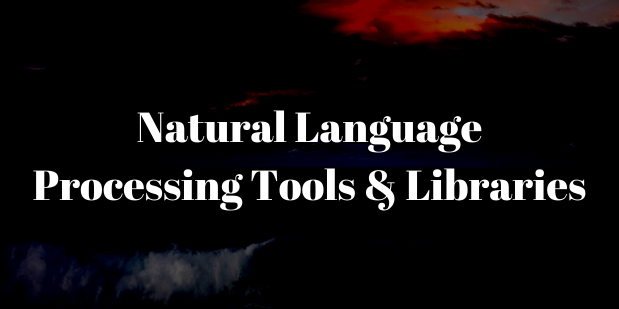Natural Language Processing Tools & Libraries

Natural Language Processing is a subfield of linguistics, computer science, artificial intelligence, information engineering and many more that complete the interactions between computers and human languages. They eventually tell us how language works or may work in specific situations. The startups and businesses understand the purposes like data analytics, user interface optimization and also value proposition.
The absence of NLP tools has hindered the development of technologies, but in the late 90s things had changed as various text analytics and generative software started to show their potential. If you see in the market right now then there are a lot of such NLP tools which can help you with your business. And with so much variety, it is difficult to choose from different natural language processing tools for your project. So, today we will look at the most popular natural language processing tools, their features and their usage.
8 Best NLP tools and libraries
1. NLTK – Entry Level Open Source NLP Tool
NLTK is an open source software powered with python natural language toolkit. It is developed for research & education and is a standard NLP tool. It gives a basic set of tools for text related operations and if you are a beginner in NLP. The major features that NLTK includes are Text classification, Entity, extraction, Part of speech tagging, Tokenization, parsing, Semantic reasoning, stemming. It’s interface include lexical resources & text Corpora and which eventually includes:
a.Open Multilingual Wordnet
b.Lin’s Dependency Thesaurus
c.Problem Report Corpus
d.Penn Treebank Corpus
Such advancement in technology allows extracting many insights, including customer activities, their opinions about your project, and constructive feedback.
2. Stanford Core NLP – Data Analysis, Sentiment Analysis, Conversational UI
If we have to define Stanford NLP then it is a multi-purpose tool for text analysis as it provides many different natural language processing software. And if you still require more than you can also use custom modules. The main advantage of Stanford natural processing software is scalability. It is a perfect choice for processing large amounts of data and performing complex operations. It also provides:
a.Sentiment analysis for social media and customer support
b.Text processing & generation for customer support, e-commerce
c.Information scraping from open source for user-generated reviews as well as for social media
d.Conversational Interfaces for chatbots
Stanford NLP can extract all sorts of information and has smooth entity recognition along with easy mark up of terms and phrases.
3. Apache OpenNLP – Data Analysis & Sentiment Analysis
When we require NLP tools then we want it to be easily accessible and less complex at the same time. It is one of the very important aspects that we need to consider before actually going for any NLP tool. ApacheOpenNLP tool is an open-source library that has incredible accessibility and practicality. Just like Stanford CoreNLP, it uses Java NLP libraries with Python decorators.
You can also configure OpenNLP in the way you need and get rid of unnecessary features that won’t be of any use. The Apache OpenNLP is a perfect choice for Named Entity Recognition, POS tagging, Sentence detection, and tokenization. You can also use OpenNLP for app sorts of text data analysis and sentiment analysis operations. If you are looking to prepare text corpora for your generators and conversational interfaces then you can also perform this task with OpenNLP.
4. SpaCy – Data Extraction, Data Analysis, Sentiment Analysis, Text Summarization
Spacy is the next step of the NLTK. NLTK is very slow and unreliable when it is fed with complex business applications. On the other hand, Spacy provides users with smoother, faster and efficient experience. It is an open-source NLP library, and is a perfect match for comparing customer profiles, product profiles or text documents. Spacy is a perfect tool for syntactic analysis, which is quite difficult for aspect-based sentiment analysis and conversational user interface optimization. If you need named-entity recognition for your business then SpaCy will serve this purpose very graciously.
Another advantage of SpaCy is word vector usage. Unlike OpenNLP and CoreNLP, SpaCy works with word2vec and doc2vec. But its best advantage would be its API. SpaCy got all functions combined at one as you don’t need to select modules on your own. So, you can create your frameworks from ready building blocks which you usually don’t see in Apache OpenNLP and Stanford CoreNLP.
5. AllenNLP – Text Analysis, Sentiment Analysis
AllenNLP is built on PyTorch tools & libraries, & that is one of the reasons it is perfect for data research and business applications. It evolves into a full-fledged tool for all sorts of text analysis which makes it one of the best and most advanced Natural Language Processing tools.
AllenNLP uses SpaCy open source library for data preprocessing while handling the rest processes on it’s own. It is very easy to use even the complex problems because of which it makes natural language processes simple and very feasible for inexperienced users. You can also use it for customer support as well as lead generation via website chat.
The most exciting feature of AllenNLP is Event2Mind. This tool allows you to explore user intent and reaction, essential products or service promotion. As we have already mentioned that AllenNLP is perfect for experienced and new users, it performs specific duties with predicted results and enough space for experiments.
6. GenSim – Document Analysis, Semantic Search, Data Exploration
There are many times when we all need to extract a particular piece of information for business insights. GenSim is a perfect tool for such tasks. It is also an open source NLP library that is designed for document exploration topic modeling and helps in navigating the various databases and documents.
Its key feature is word vectors that sees the content of the documents as sequences of vectors and clusters. And then, GenSim easily classifies them. It is also resource saving when it comes to dealing with a huge pile of data. However, it is mainly used for data analysis, text generation applications and semantic search applications.
7. TextBlob Library – Conversational UI, Sentiment Analysis
It is the fastest natural language processing tool. TextBlob is another open-source NLP tool powered with NLTK, it can also be enhanced by adding extra features for better and in depth analysis. You can use it for sentiment analysis for customer engagement via conversational interfaces. Another useful feature is machine translation. With TextBlob, you can optimize the automatic translation using its language text corpora.
TextBlob also provides tools for sentiment analysis, event extraction and intent analysis features, however it uses a different but a flexible model for sentiment analysis which allows you to build an entire timelines of sentiments and look at things in progress.
8. Intel NLP Architect – Data Exploration, Conversational UI3
It is the new invention in the market that uses Python library for deep learning using recurrent neural networks. It can use NLP Architect for aspect based sentiment analysis , text generation and summarization and conversational interfaces such as chatbots. Its most exciting feature is Machine Reading Comprehension.
It applies a multi-layered approach by using many permutations and generated text transfigurations. In simpler words, it makes the output capable of adapting the style and presentation to the appropriate text state based on the input data. You can also use it for more personalized service. NPL Architect is the most advanced tool being one step further, getting deeper into the sets of text data for more business insights.
NLP tools are about analyzing text data and receiving useful business insights out of it. We can understand that it is hard to figure out the best NLP tool for your business but you should be aware of the alternatives and this list will help you with it. We hope this list will help you in distinguishing all the available tools and in choosing the best one for your business, services or products.





I’m extremely impressed with your writing talents as smartly as with the layout on your weblog. Is this a paid theme or did you modify it your self? Anyway stay up the nice high quality writing, it is rare to peer a great blog like this one today.